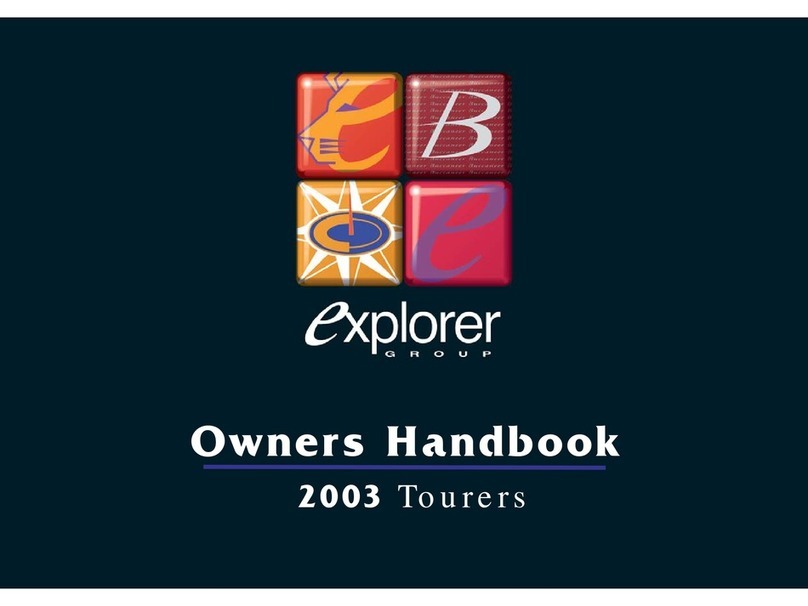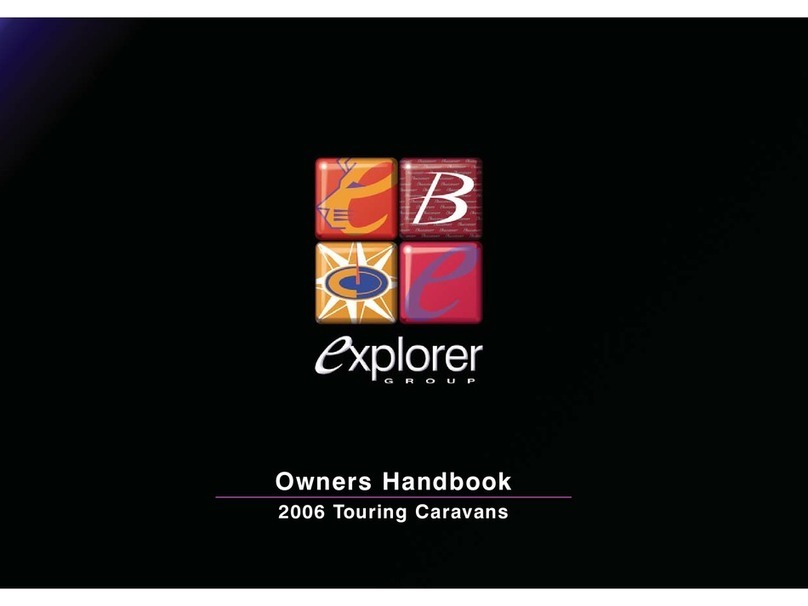GENERAL SAFETY
In order for you to get the most out of your new
Explorer Group caravan it is necessary for you
to be aware of the following.
1. Do not obstruct ventilators.
2. Inspect the flexible gas hose regularly for
deterioration and renew as necessary, with
approved type, and in any case no later
than the expiry date stated on the hose.
3. It is recommended that you provide a dry
powder fire extinguisher complying with
ISO 7165 of at least 1 KG capacity by the
exit door and a fire blanket next to the
cooker. Ensure you read the 'advice to
occupier label' fitted to your caravan.
4. Never use portable cooking or heating
equipment inside your caravan. Do not use
your fitted cooking equipment as heating
at any time.
5. Never allow modification to your gas or
electrical system unless qualified persons
carry them out. All modification to the gas
system should be carried out by a CORGI
registered gas fitter. Any modifications
carried out on the electrical system should
be carried out by an electrician on the roll
of the NICEIC or be a member of the ECA.
6. Never exceed your caravans Maximum
Technical Permissible Laden Mass.
7. Never exceed the caravan or your cars
maximum nose weight whichever is the
lower.
8. Care shall be taken against the risk of
falling out when children, especially under
3 years of age, use the upper bunk.
9. Ensure heavy and large items are secured
before towing your new caravan to reduce
the risk of damage being caused while the
caravan is in motion.
10. Turn off all gas appliances and turn off the
gas supply before towing your caravan.
11. Do not leave children under 14 years of
age unattended in your caravan.
12. When your caravan is connected to your
towing vehicle it should be level or slightly
nose down. An excessive nose down
attitude or a nose up attitude could lead to
instability when towing.
VENTILATION
All caravans manufactured by the Explorer
Group Limited are ventilated at both high and
low level in accordance with BSEN 721 Safety
Ventilation. The fixed ventilation points fitted in
your caravan must not be blocked under any
circumstances as your safety may depend
upon them.
It is advisable that the fixed ventilation points
are checked and cleaned (where necessary)
on a regular basis.
HIGH-LEVEL VENTILATION
This is always provided by fixed ventilation
within the fitted roof skylight. All roof skylights
fitted by Explorer Group provide fixed free area
ventilation. These roof skylights should be
cleaned annually by use of a small brush to
remove any dust that may have accumulated
around the mesh fitted. On some roof skylights
the mesh can be easily removed to aid
cleaning. On fan-assisted roof skylights it is
essential that the roof skylight be switched off
prior to cleaning.
LOW-LEVEL VENTILATION
Low level ventilation is provided under the front
chest of drawers, except in an L-shape layout,
where it can be found either in the nearside or
offside bed box. The exact position can be
identified via the white plastic cover used to
prevent the ventilation from being obstructed.
In order to clean the ventilator, remove the
cover by undoing the two screws and clean
using a small brush. It is essential that the
cover is replaced once cleaning is complete.
SEPARATE BEDROOMS
In caravans with sleeping areas separated via
a solid door, separate ventilation is required
and is provided via a roof skylight at high level
and a ventilator at low level within a bed box.
4
SAFETY RECOMMENDATIONS






























